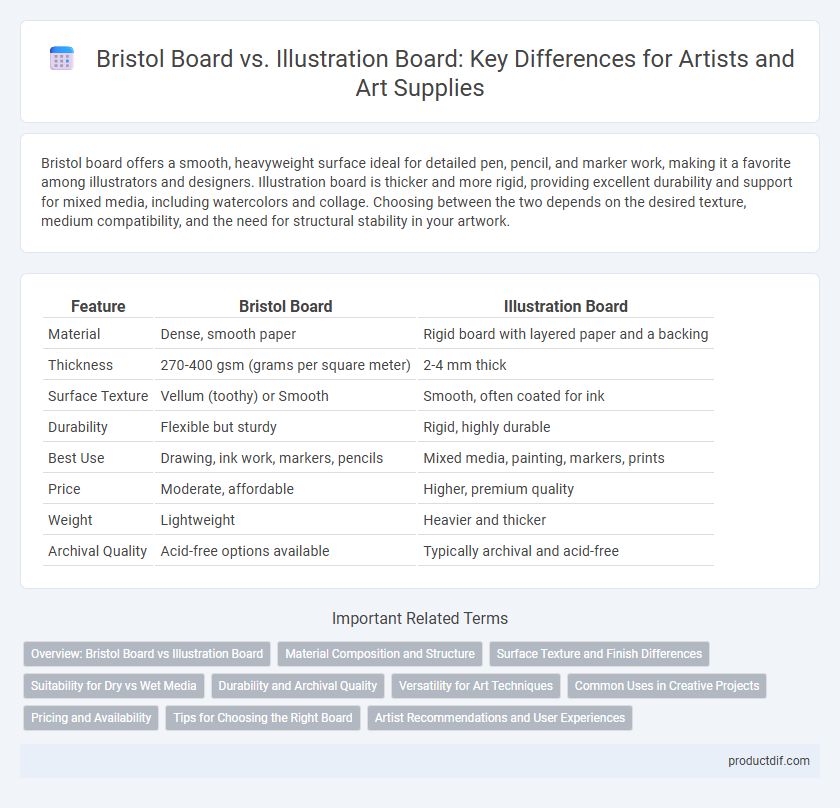Bristol board offers a smooth, heavyweight surface ideal for detailed pen, pencil, and marker work, making it a favorite among illustrators and designers. Illustration board is thicker and more rigid, providing excellent durability and support for mixed media, including watercolors and collage. Choosing between the two depends on the desired texture, medium compatibility, and the need for structural stability in your artwork.
Table of Comparison
| Feature | Bristol Board | Illustration Board |
|---|---|---|
| Material | Dense, smooth paper | Rigid board with layered paper and a backing |
| Thickness | 270-400 gsm (grams per square meter) | 2-4 mm thick |
| Surface Texture | Vellum (toothy) or Smooth | Smooth, often coated for ink |
| Durability | Flexible but sturdy | Rigid, highly durable |
| Best Use | Drawing, ink work, markers, pencils | Mixed media, painting, markers, prints |
| Price | Moderate, affordable | Higher, premium quality |
| Weight | Lightweight | Heavier and thicker |
| Archival Quality | Acid-free options available | Typically archival and acid-free |
Overview: Bristol Board vs Illustration Board
Bristol board features a smooth, heavyweight surface ideal for detailed pen, ink, and pencil work, while illustration board offers a thicker, more rigid structure suited for mixed media and painting techniques. Bristol board typically comes in two finishes: smooth and vellum, providing versatility in texture, whereas illustration board often includes a rigid backing that prevents warping. Both boards support archival-quality artwork, but the choice depends on the medium and desired durability for the final piece.
Material Composition and Structure
Bristol board consists of multiple layers of paper laminated together, offering a smooth, uniform surface ideal for detailed pen and ink work. Illustration board features a thick, rigid core made from compressed paper fibers or cardboard with a single outer paper surface, providing greater durability and support for mixed media and heavier applications. The composition of Bristol board emphasizes lightweight flexibility, while illustration board prioritizes structural strength and resistance to warping.
Surface Texture and Finish Differences
Bristol Board features a smooth, vellum, or plate finish, offering a fine texture ideal for detailed pen, pencil, and marker work, while Illustration Board presents a heavier, rigid surface with a toothier texture designed to hold various media, including paint and collage elements. The finish on Bristol Board tends to be less absorbent, providing crisp lines and minimal feathering, whereas Illustration Board's textured surface enhances paint adhesion and layering for mixed media techniques. Choosing between the two depends on the desired visual effect and medium compatibility, with Bristol Board excelling in precision and Illustration Board preferred for durability and texture-rich applications.
Suitability for Dry vs Wet Media
Bristol board features a smooth, hot-pressed surface ideal for detailed dry media such as graphite, charcoal, and colored pencils, providing excellent control and fine lines. Illustration board is thicker and more rigid, often with a clay-coated surface, making it suitable for wet media like gouache and acrylics due to its ability to withstand moisture without warping. Artists select Bristol for precision in dry applications and Illustration board for durability and texture in wet techniques.
Durability and Archival Quality
Bristol Board offers a smooth surface ideal for detailed ink and pencil work but tends to be less durable and more prone to warping over time compared to Illustration Board. Illustration Board features a rigid core that provides superior strength and resistance to bending, making it more suitable for long-term archival projects. Both boards are acid-free, but Illustration Board generally ensures better archival quality due to its robust construction and thicker layers.
Versatility for Art Techniques
Bristol board offers exceptional versatility for various art techniques such as pen and ink, markers, and light watercolor washes due to its smooth surface and durability. Illustration board provides a thicker, more rigid substrate ideal for heavy media including acrylics, gouache, and mixed media applications that require robust support. Artists selecting between the two should consider Bristol board for detailed, fine-line work and Illustration board for heavier, textured techniques demanding stability.
Common Uses in Creative Projects
Bristol Board is widely favored for detailed pen, pencil, and ink work due to its smooth surface, making it ideal for comic art, calligraphy, and fine line drawings. Illustration Board offers a sturdier, thicker option often used for mixed media applications, including watercolor, gouache, and collage, providing durability and excellent support for heavier media. Creative projects that require high-quality presentation or framing frequently utilize illustration board for its rigid backing and professional finish.
Pricing and Availability
Bristol Board typically costs less than Illustration Board due to its lighter weight and simpler manufacturing process. Illustration Board, made with a thicker core and higher-quality surface, is often priced higher and found in specialty art stores or online retailers. Availability of Bristol Board is wider, making it a more accessible option for artists on a budget.
Tips for Choosing the Right Board
When selecting between Bristol Board and Illustration Board, consider the project's medium and desired texture; Bristol Board is smooth and ideal for detailed pencil, pen, and marker work, while Illustration Board offers a firmer surface suited for mixed media and heavier paints. Weight and thickness matter--Illustration Boards typically provide greater rigidity for framing and handling, whereas Bristol Boards vary from lightweight to heavyweight options perfect for layering and precision. Prioritize archival quality and surface finish to ensure durability and the best outcome for your artwork.
Artist Recommendations and User Experiences
Artists recommend Bristol Board for its smooth surface, ideal for detailed pen, ink, and marker work, while Illustration Board is favored for mixed media and heavy applications due to its thickness and durability. User experiences highlight Bristol Board's ability to prevent ink bleed and provide a clean finish, whereas Illustration Board supports layering techniques and withstands erasing without warping. Both boards offer excellent archival quality, but choice depends on the medium and project complexity preferred by the artist.
Bristol Board vs Illustration Board Infographic

 productdif.com
productdif.com